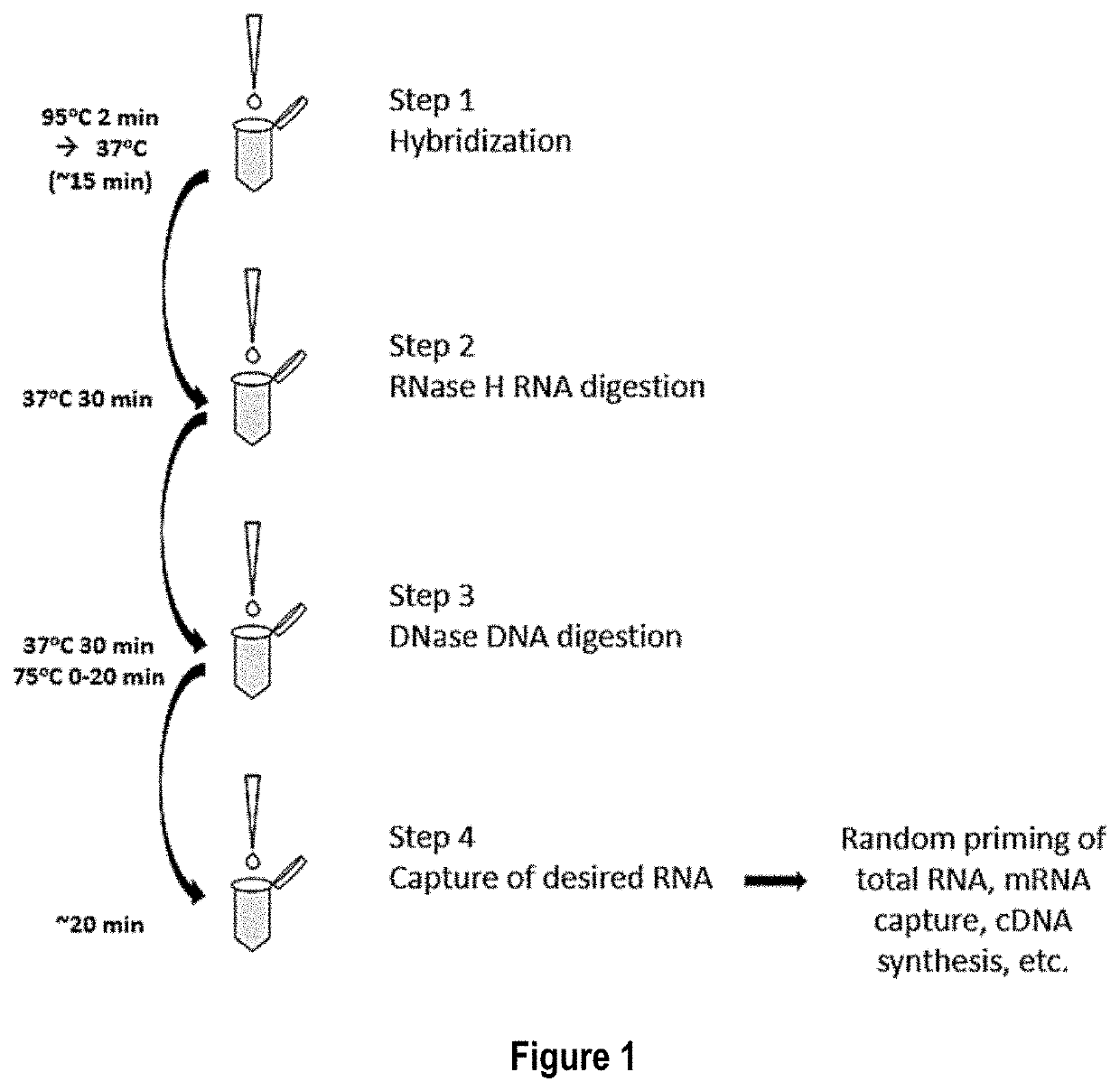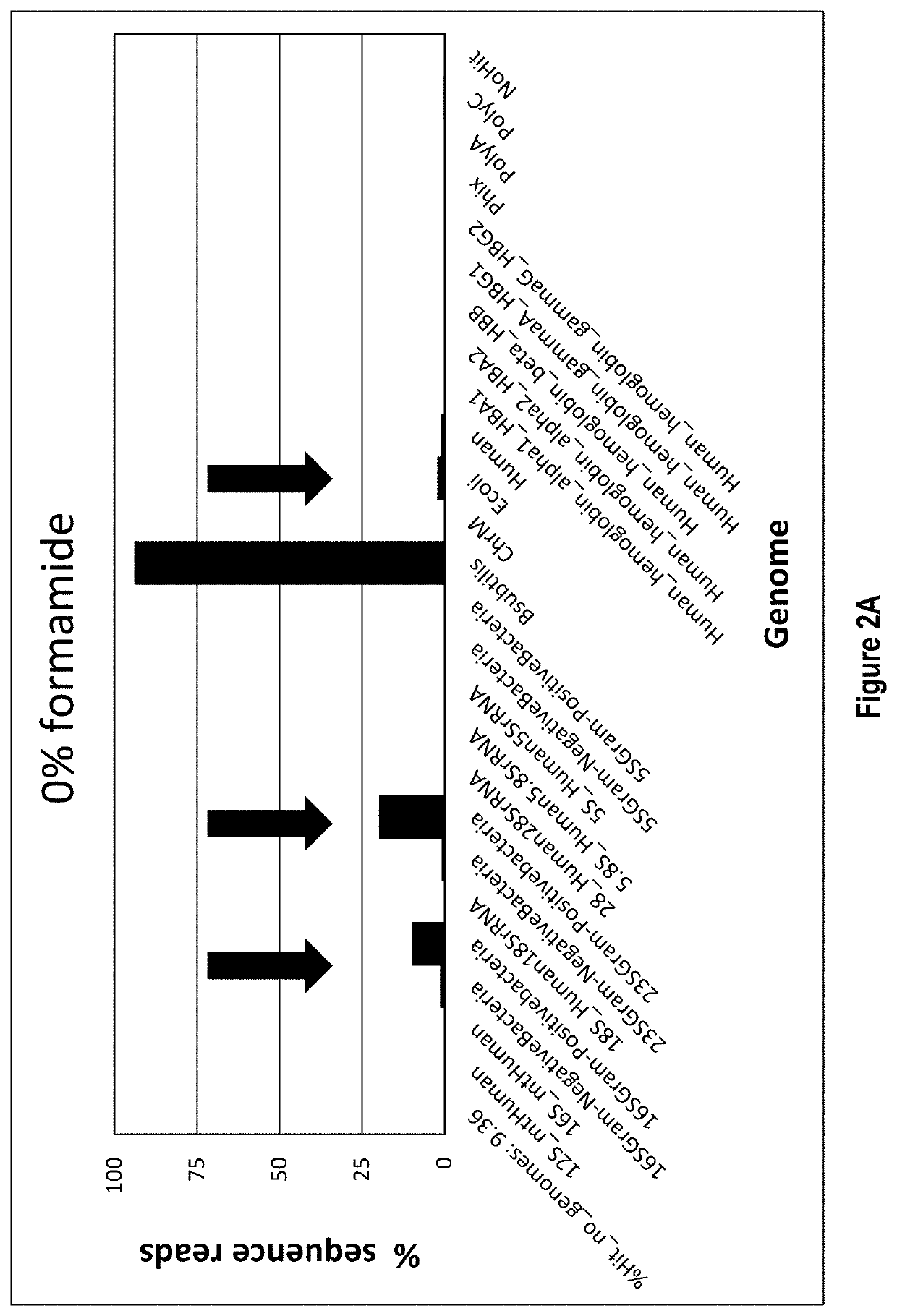Nuclease-based RNA depletion
a technology of rna and nuclease, applied in the field of nuclease-based rna depletion, can solve the problems of reducing the ability of researchers to accurately analyze the desired portion of the transcriptome, and achieve the effects of improving the accuracy of analysis, and improving the specificity and accuracy of analysis
- Summary
- Abstract
- Description
- Claims
- Application Information
AI Technical Summary
Benefits of technology
Problems solved by technology
Method used
Image
Examples
example 1
of Unwanted RNA Species from a Sample
[0070]In this example total RNA is the target nucleic acid in the sample, and RNA depletion involves four main steps: 1) hybridization, 2) RNase H treatment, 3) DNase treatment, and 4) target RNA clean up.
[0071]Hybridization is accomplished by annealing a defined DNA probe set to denatured RNA in a sample. A RNA sample, 10-100 ng, is incubated in a tube with 1 μL of a 1 μM / oligo DNA oligo probe set (probes corresponding to SEQ ID NOs: 1-333, as listed in Table 1), 3 μL of 5× Hybridization buffer (500 mM Tris HCl pH 7.5 and 1000 mM KCl), 2.5 μL of 100% formamide and enough water for a total reaction volume of 15 μL. The hybridization reaction is incubated at 95° C. for 2 min to denature the nucleic acids, slow cooled to 37° C. by decreasing temperature 0.1° C. / sec and held at 37° C. No incubation time needed once the reaction reaches 37° C. The total time it takes for denaturation to reach 37° C. is about 15 min.
[0072]Following hybridization, the ...
example 2
hesis
[0076]Further processing of the RNA from Example 1 could be making a library preparation from the RNA target nucleic acids that can be sequenced for example by NGS. To 8.5 μL of the final reaction from Example 1, 8.5 μL of Elute, Prime High Concentration Random Hexamer Mix buffer (EPH buffer, TruSeq Stranded Total RNA Kit, Illumina) is added for a total volume of 17 μL. The sample is incubated at 65° C. for 2 min to denature the nucleic acids. Following denaturation, the reaction tube can be held on ice. First strand synthesis is performed by adding 8 μL of a reverse transcription enzyme mix (9 μL First Strand Synthesis Mix (FSA, TruSeq Stranded Total RNA Kit, Illumina) and 1 μL Protoscript II RT, (NEB)) to the denatured sample for a total volume of 25 μL. The reaction mix is incubated in a heated lid thermocycler under the following conditions: 25° C. for 5 min, 42° C. for 25 min, 70° C. for 15 min. Once the first strand synthesis reaction is complete the reaction tube can be ...
example 3
reparation for Next Generation Sequencing
[0079]One method for preparing a library for sequencing includes A-tailing cDNA fragments, ligating adaptors, amplifying target fragments, and quantifying resultant fragments prior to sequencing.
[0080]The tube with 17.5 μL of purified cDNA from Example 2 is used for processing. To the purified cDNA is added 12.5 μL ATL (Illumina) for A-tailing the fragments. The reaction tube is incubated at 37° C. for 30 min followed by incubating at 70° C. for 5 min and the tube is put back on ice. Adaptors are ligated to the A-tailed sample by added in order: 2.5 μL RSB, 2.5 μL Index Adaptors (TruSeq Stranded Total RNA Kit, Illumina) and 2.5 μL of Ligation buffer (Illumina). The reaction tube is incubated at 30° C. for 10 min after which point 5 μL of Stop Ligation buffer (Illumina) is added and the reaction is held on ice.
[0081]Once the adaptor ligation reaction is completed, the ligated fragments are separated from the reaction components. To purify the ...
PUM
| Property | Measurement | Unit |
|---|---|---|
| volume | aaaaa | aaaaa |
| volume | aaaaa | aaaaa |
| volume | aaaaa | aaaaa |
Abstract
Description
Claims
Application Information
 Login to View More
Login to View More - R&D
- Intellectual Property
- Life Sciences
- Materials
- Tech Scout
- Unparalleled Data Quality
- Higher Quality Content
- 60% Fewer Hallucinations
Browse by: Latest US Patents, China's latest patents, Technical Efficacy Thesaurus, Application Domain, Technology Topic, Popular Technical Reports.
© 2025 PatSnap. All rights reserved.Legal|Privacy policy|Modern Slavery Act Transparency Statement|Sitemap|About US| Contact US: help@patsnap.com



